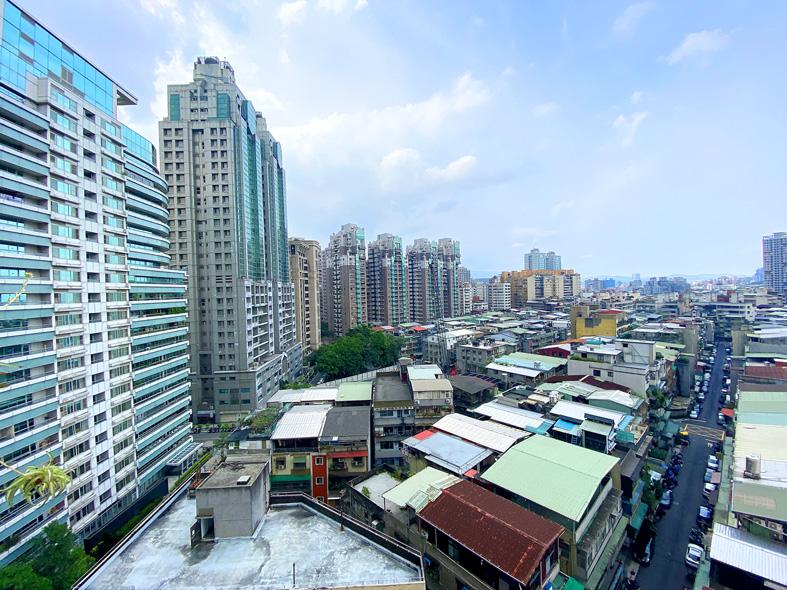The number of unoccupied houses nationwide totaled 876,000 units last year, or 11.94 percent of all houses, the Ministry of the Interior said in a report issued on Thursday.
Almost 30 percent of empty houses were owned by companies, suggesting that many corporate property owners engage in house hoarding, the ministry said.
Excluding developers and builders, companies still owned 20 percent of empty houses, it said.

Photo: CNA
The report is based on housing units’ electricity use and considers properties that use less than 60 kilowatt-hours per month as unoccupied.
The study contradicts Ministry of Finance reports saying that house hoarding subsided and there is no need for housing tax increases.
To rein in property price increases due to house hoarding, the central bank in March capped the loan-to-value ratio at 40 percent for firms and 50 percent for individuals buying their fourth or more.
The interior ministry found that New Taipei City had the highest number of unoccupied houses at 152,000, followed by Kaohsiung with 117,000; Taichung with 105,000; Taoyuan with 102,000; Tainan with 78,000; and Taipei with 68,000.
The report said that 33.47 percent of corporate-owned empty houses were held by companies that owned more than 10 houses.
Individual owners of more than 10 houses held 18.74 percent of all empty houses, it said.
A domestic COVID-19 outbreak in May prompted the central bank to postpone planned measures to rein in house hoarding, even though property and construction lending continued to rise, defying expectations of a downturn.
Separately, Miaoli County-based tile producer Champion Building Materials Co (冠軍建材) yesterday said that it is seeking to reverse losses this year by expanding its domestic market share and booking income from the sale of a production facility in China.
Champion last year incurred losses of NT$403 million (US$14.41 million), or losses per share of NT$0.93, the company told its annual general meeting in Jhunan Township (竹南) on Tuesday, citing sharp competition from low-end producers.
However, the situation might improve this year, as Champion sold an idle production facility in Kunshan, China, amid rising real-estate prices in the emerging high-tech production hub, it said.
The transaction generated NT$1.08 billion in profit, it said.
Revenue contribution from Champion’s China business was 25 percent last year, while the rest came from the domestic market, the company said.

Taiwan Semiconductor Manufacturing Co (TSMC, 台積電) has secured three construction permits for its plan to build a state-of-the-art A14 wafer fab in Taichung, and is likely to start construction soon, the Central Taiwan Science Park Bureau said yesterday. Speaking with CNA, Wang Chun-chieh (王俊傑), deputy director general of the science park bureau, said the world’s largest contract chipmaker has received three construction permits — one to build a fab to roll out sophisticated chips, another to build a central utility plant to provide water and electricity for the facility and the other to build three office buildings. With the three permits, TSMC

The DBS Foundation yesterday announced the launch of two flagship programs, “Silver Motion” and “Happier Caregiver, Healthier Seniors,” in partnership with CCILU Ltd, Hondao Senior Citizens’ Welfare Foundation and the Garden of Hope Foundation to help Taiwan face the challenges of a rapidly aging population. The foundation said it would invest S$4.91 million (US$3.8 million) over three years to foster inclusion and resilience in an aging society. “Aging may bring challenges, but it also brings opportunities. With many Asian markets rapidly becoming super-aged, the DBS Foundation is working with a regional ecosystem of like-minded partners across the private, public and people sectors

RUN IT BACK: A succesful first project working with hyperscalers to design chips encouraged MediaTek to start a second project, aiming to hit stride in 2028 MediaTek Inc (聯發科), the world’s biggest smartphone chip supplier, yesterday said it is engaging a second hyperscaler to help design artificial intelligence (AI) accelerators used in data centers following a similar project expected to generate revenue streams soon. The first AI accelerator project is to bring in US$1 billion revenue next year and several billion US dollars more in 2027, MediaTek chief executive officer Rick Tsai (蔡力行) told a virtual investor conference yesterday. The second AI accelerator project is expected to contribute to revenue beginning in 2028, Tsai said. MediaTek yesterday raised its revenue forecast for the global AI accelerator used

BREAKTHROUGH TECH: Powertech expects its fan-out PLP system to become mainstream, saying it can offer three-times greater production throughput Chip packaging service provider Powertech Technology Inc (力成科技) plans to more than double its capital expenditures next year to more than NT$40 billion (US$1.31 billion) as demand for its new panel-level packaging (PLP) technology, primarily used in chips for artificial intelligence (AI) applications, has greatly exceeded what it can supply. A significant portion of the budget, about US$1 billion, would be earmarked for fan-out PLP technology, Powertech told investors yesterday. Its heavy investment in fan-out PLP technology over the past 10 years is expected to bear fruit in 2027 after the technology enters volume production, it said, adding that the tech would